Factors to Consider Before Choosing Internal or External Change Agents in Organizational Change Management
VerifiedAdded on 2024/05/14
|10
|2663
|169
AI Summary
This essay explores the factors to consider before selecting internal or external change agents in organizational change management. It discusses the roles of internal and external agents, factors influencing change decisions, and the impact of these decisions on organizational development.
Contribute Materials
Your contribution can guide someone’s learning journey. Share your
documents today.

Page 1 of 10
CHANGE MANAGEMENT
ORGANISATIONS UNDERGOES CHANGE EMPLOY
INTERNAL AND EXTERNAL CHANGE AGENTS. WHAT
FACTORS MUST BE CONSIDERED BEFORE MAKING A
CHOICE? JUSTIFY YOUR ANSWER WITH EXAMPLES
CHANGE MANAGEMENT
ORGANISATIONS UNDERGOES CHANGE EMPLOY
INTERNAL AND EXTERNAL CHANGE AGENTS. WHAT
FACTORS MUST BE CONSIDERED BEFORE MAKING A
CHOICE? JUSTIFY YOUR ANSWER WITH EXAMPLES
Secure Best Marks with AI Grader
Need help grading? Try our AI Grader for instant feedback on your assignments.
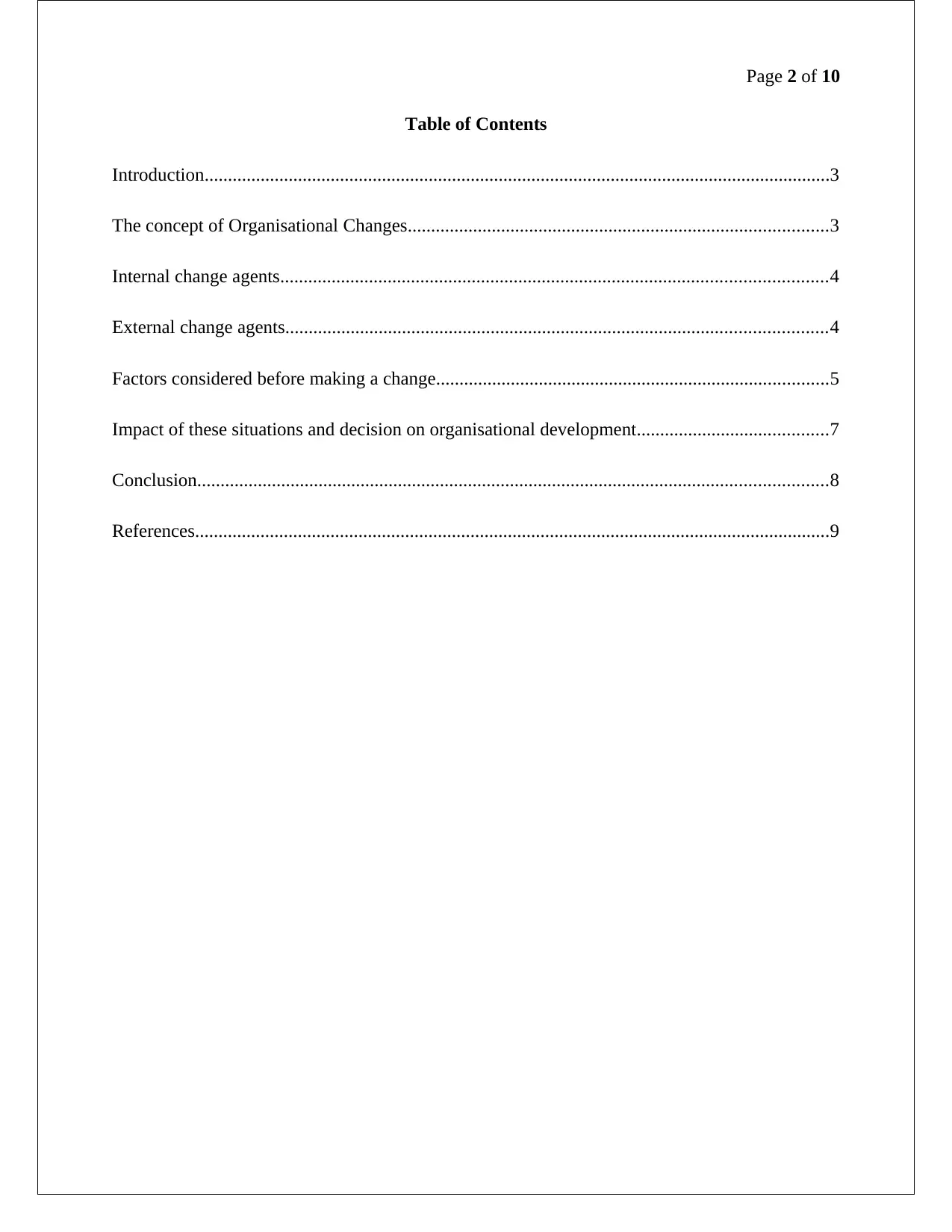
Page 2 of 10
Table of Contents
Introduction......................................................................................................................................3
The concept of Organisational Changes..........................................................................................3
Internal change agents.....................................................................................................................4
External change agents....................................................................................................................4
Factors considered before making a change....................................................................................5
Impact of these situations and decision on organisational development.........................................7
Conclusion.......................................................................................................................................8
References........................................................................................................................................9
Table of Contents
Introduction......................................................................................................................................3
The concept of Organisational Changes..........................................................................................3
Internal change agents.....................................................................................................................4
External change agents....................................................................................................................4
Factors considered before making a change....................................................................................5
Impact of these situations and decision on organisational development.........................................7
Conclusion.......................................................................................................................................8
References........................................................................................................................................9
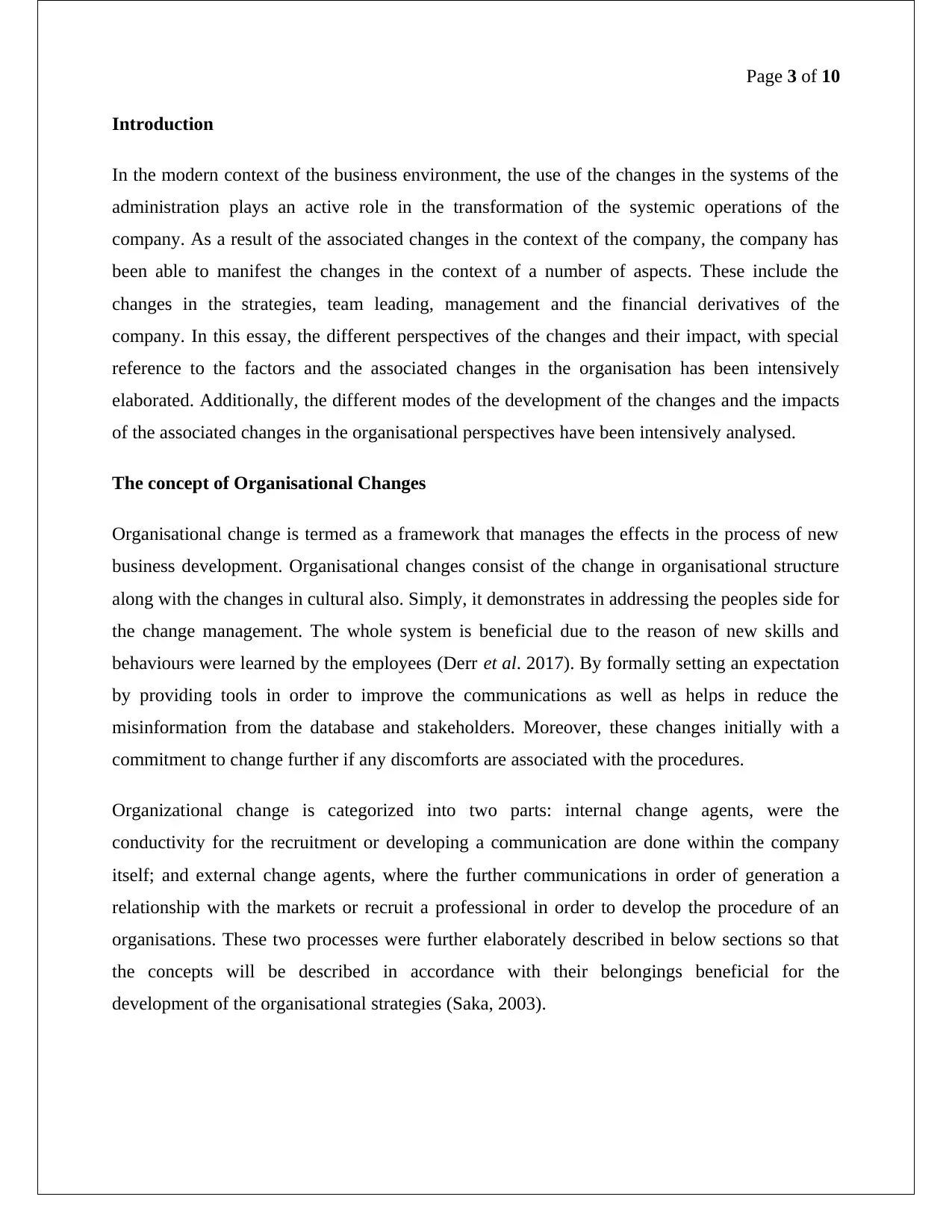
Page 3 of 10
Introduction
In the modern context of the business environment, the use of the changes in the systems of the
administration plays an active role in the transformation of the systemic operations of the
company. As a result of the associated changes in the context of the company, the company has
been able to manifest the changes in the context of a number of aspects. These include the
changes in the strategies, team leading, management and the financial derivatives of the
company. In this essay, the different perspectives of the changes and their impact, with special
reference to the factors and the associated changes in the organisation has been intensively
elaborated. Additionally, the different modes of the development of the changes and the impacts
of the associated changes in the organisational perspectives have been intensively analysed.
The concept of Organisational Changes
Organisational change is termed as a framework that manages the effects in the process of new
business development. Organisational changes consist of the change in organisational structure
along with the changes in cultural also. Simply, it demonstrates in addressing the peoples side for
the change management. The whole system is beneficial due to the reason of new skills and
behaviours were learned by the employees (Derr et al. 2017). By formally setting an expectation
by providing tools in order to improve the communications as well as helps in reduce the
misinformation from the database and stakeholders. Moreover, these changes initially with a
commitment to change further if any discomforts are associated with the procedures.
Organizational change is categorized into two parts: internal change agents, were the
conductivity for the recruitment or developing a communication are done within the company
itself; and external change agents, where the further communications in order of generation a
relationship with the markets or recruit a professional in order to develop the procedure of an
organisations. These two processes were further elaborately described in below sections so that
the concepts will be described in accordance with their belongings beneficial for the
development of the organisational strategies (Saka, 2003).
Introduction
In the modern context of the business environment, the use of the changes in the systems of the
administration plays an active role in the transformation of the systemic operations of the
company. As a result of the associated changes in the context of the company, the company has
been able to manifest the changes in the context of a number of aspects. These include the
changes in the strategies, team leading, management and the financial derivatives of the
company. In this essay, the different perspectives of the changes and their impact, with special
reference to the factors and the associated changes in the organisation has been intensively
elaborated. Additionally, the different modes of the development of the changes and the impacts
of the associated changes in the organisational perspectives have been intensively analysed.
The concept of Organisational Changes
Organisational change is termed as a framework that manages the effects in the process of new
business development. Organisational changes consist of the change in organisational structure
along with the changes in cultural also. Simply, it demonstrates in addressing the peoples side for
the change management. The whole system is beneficial due to the reason of new skills and
behaviours were learned by the employees (Derr et al. 2017). By formally setting an expectation
by providing tools in order to improve the communications as well as helps in reduce the
misinformation from the database and stakeholders. Moreover, these changes initially with a
commitment to change further if any discomforts are associated with the procedures.
Organizational change is categorized into two parts: internal change agents, were the
conductivity for the recruitment or developing a communication are done within the company
itself; and external change agents, where the further communications in order of generation a
relationship with the markets or recruit a professional in order to develop the procedure of an
organisations. These two processes were further elaborately described in below sections so that
the concepts will be described in accordance with their belongings beneficial for the
development of the organisational strategies (Saka, 2003).
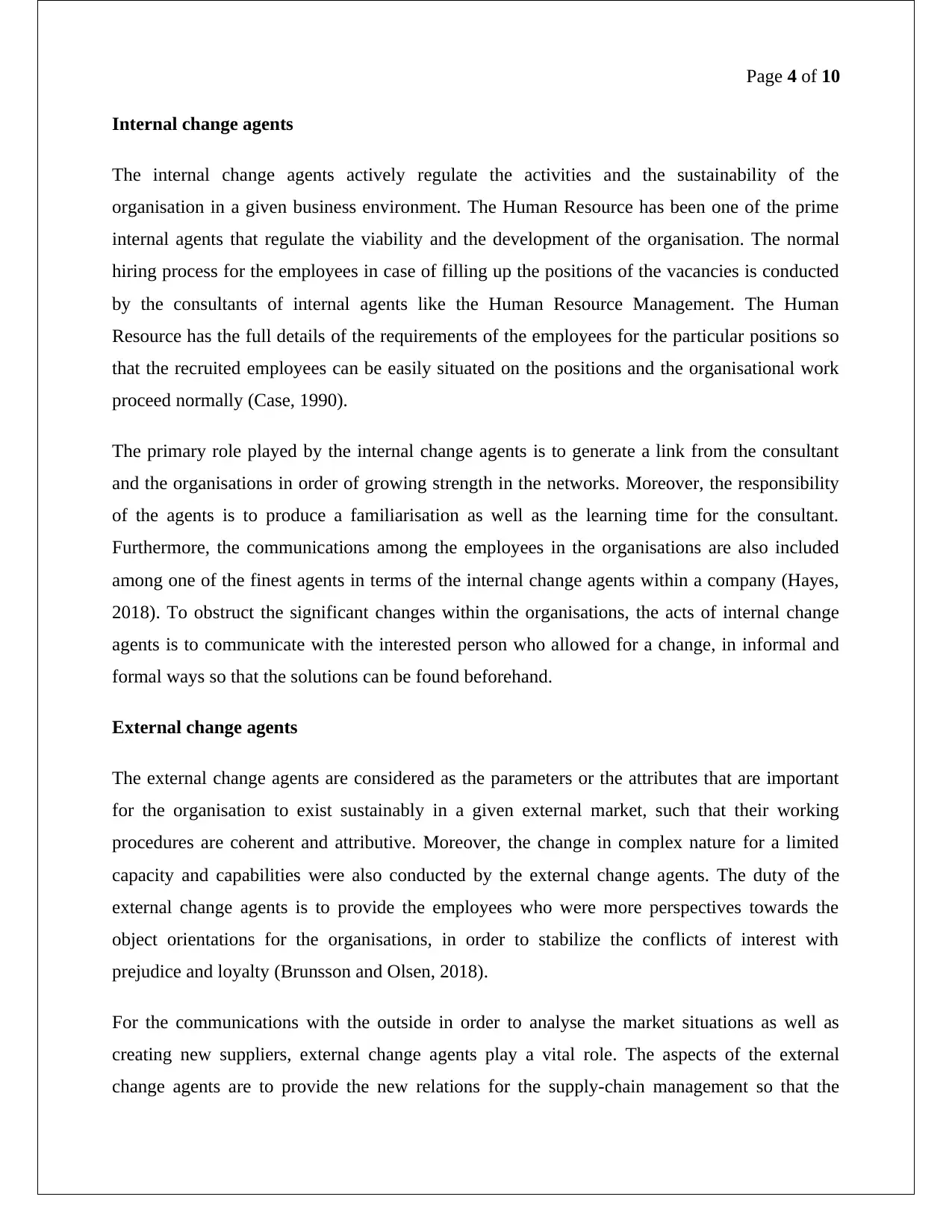
Page 4 of 10
Internal change agents
The internal change agents actively regulate the activities and the sustainability of the
organisation in a given business environment. The Human Resource has been one of the prime
internal agents that regulate the viability and the development of the organisation. The normal
hiring process for the employees in case of filling up the positions of the vacancies is conducted
by the consultants of internal agents like the Human Resource Management. The Human
Resource has the full details of the requirements of the employees for the particular positions so
that the recruited employees can be easily situated on the positions and the organisational work
proceed normally (Case, 1990).
The primary role played by the internal change agents is to generate a link from the consultant
and the organisations in order of growing strength in the networks. Moreover, the responsibility
of the agents is to produce a familiarisation as well as the learning time for the consultant.
Furthermore, the communications among the employees in the organisations are also included
among one of the finest agents in terms of the internal change agents within a company (Hayes,
2018). To obstruct the significant changes within the organisations, the acts of internal change
agents is to communicate with the interested person who allowed for a change, in informal and
formal ways so that the solutions can be found beforehand.
External change agents
The external change agents are considered as the parameters or the attributes that are important
for the organisation to exist sustainably in a given external market, such that their working
procedures are coherent and attributive. Moreover, the change in complex nature for a limited
capacity and capabilities were also conducted by the external change agents. The duty of the
external change agents is to provide the employees who were more perspectives towards the
object orientations for the organisations, in order to stabilize the conflicts of interest with
prejudice and loyalty (Brunsson and Olsen, 2018).
For the communications with the outside in order to analyse the market situations as well as
creating new suppliers, external change agents play a vital role. The aspects of the external
change agents are to provide the new relations for the supply-chain management so that the
Internal change agents
The internal change agents actively regulate the activities and the sustainability of the
organisation in a given business environment. The Human Resource has been one of the prime
internal agents that regulate the viability and the development of the organisation. The normal
hiring process for the employees in case of filling up the positions of the vacancies is conducted
by the consultants of internal agents like the Human Resource Management. The Human
Resource has the full details of the requirements of the employees for the particular positions so
that the recruited employees can be easily situated on the positions and the organisational work
proceed normally (Case, 1990).
The primary role played by the internal change agents is to generate a link from the consultant
and the organisations in order of growing strength in the networks. Moreover, the responsibility
of the agents is to produce a familiarisation as well as the learning time for the consultant.
Furthermore, the communications among the employees in the organisations are also included
among one of the finest agents in terms of the internal change agents within a company (Hayes,
2018). To obstruct the significant changes within the organisations, the acts of internal change
agents is to communicate with the interested person who allowed for a change, in informal and
formal ways so that the solutions can be found beforehand.
External change agents
The external change agents are considered as the parameters or the attributes that are important
for the organisation to exist sustainably in a given external market, such that their working
procedures are coherent and attributive. Moreover, the change in complex nature for a limited
capacity and capabilities were also conducted by the external change agents. The duty of the
external change agents is to provide the employees who were more perspectives towards the
object orientations for the organisations, in order to stabilize the conflicts of interest with
prejudice and loyalty (Brunsson and Olsen, 2018).
For the communications with the outside in order to analyse the market situations as well as
creating new suppliers, external change agents play a vital role. The aspects of the external
change agents are to provide the new relations for the supply-chain management so that the
Secure Best Marks with AI Grader
Need help grading? Try our AI Grader for instant feedback on your assignments.
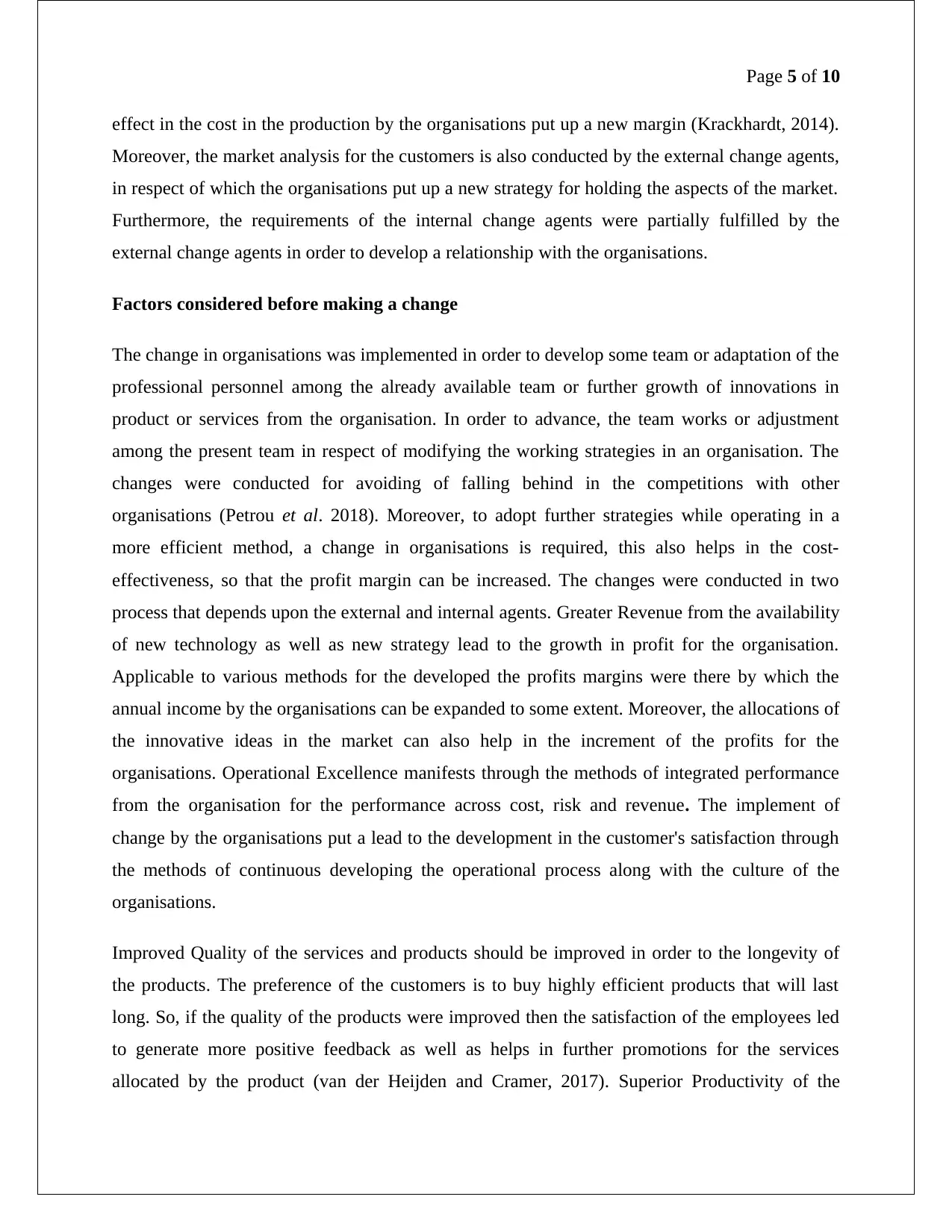
Page 5 of 10
effect in the cost in the production by the organisations put up a new margin (Krackhardt, 2014).
Moreover, the market analysis for the customers is also conducted by the external change agents,
in respect of which the organisations put up a new strategy for holding the aspects of the market.
Furthermore, the requirements of the internal change agents were partially fulfilled by the
external change agents in order to develop a relationship with the organisations.
Factors considered before making a change
The change in organisations was implemented in order to develop some team or adaptation of the
professional personnel among the already available team or further growth of innovations in
product or services from the organisation. In order to advance, the team works or adjustment
among the present team in respect of modifying the working strategies in an organisation. The
changes were conducted for avoiding of falling behind in the competitions with other
organisations (Petrou et al. 2018). Moreover, to adopt further strategies while operating in a
more efficient method, a change in organisations is required, this also helps in the cost-
effectiveness, so that the profit margin can be increased. The changes were conducted in two
process that depends upon the external and internal agents. Greater Revenue from the availability
of new technology as well as new strategy lead to the growth in profit for the organisation.
Applicable to various methods for the developed the profits margins were there by which the
annual income by the organisations can be expanded to some extent. Moreover, the allocations of
the innovative ideas in the market can also help in the increment of the profits for the
organisations. Operational Excellence manifests through the methods of integrated performance
from the organisation for the performance across cost, risk and revenue. The implement of
change by the organisations put a lead to the development in the customer's satisfaction through
the methods of continuous developing the operational process along with the culture of the
organisations.
Improved Quality of the services and products should be improved in order to the longevity of
the products. The preference of the customers is to buy highly efficient products that will last
long. So, if the quality of the products were improved then the satisfaction of the employees led
to generate more positive feedback as well as helps in further promotions for the services
allocated by the product (van der Heijden and Cramer, 2017). Superior Productivity of the
effect in the cost in the production by the organisations put up a new margin (Krackhardt, 2014).
Moreover, the market analysis for the customers is also conducted by the external change agents,
in respect of which the organisations put up a new strategy for holding the aspects of the market.
Furthermore, the requirements of the internal change agents were partially fulfilled by the
external change agents in order to develop a relationship with the organisations.
Factors considered before making a change
The change in organisations was implemented in order to develop some team or adaptation of the
professional personnel among the already available team or further growth of innovations in
product or services from the organisation. In order to advance, the team works or adjustment
among the present team in respect of modifying the working strategies in an organisation. The
changes were conducted for avoiding of falling behind in the competitions with other
organisations (Petrou et al. 2018). Moreover, to adopt further strategies while operating in a
more efficient method, a change in organisations is required, this also helps in the cost-
effectiveness, so that the profit margin can be increased. The changes were conducted in two
process that depends upon the external and internal agents. Greater Revenue from the availability
of new technology as well as new strategy lead to the growth in profit for the organisation.
Applicable to various methods for the developed the profits margins were there by which the
annual income by the organisations can be expanded to some extent. Moreover, the allocations of
the innovative ideas in the market can also help in the increment of the profits for the
organisations. Operational Excellence manifests through the methods of integrated performance
from the organisation for the performance across cost, risk and revenue. The implement of
change by the organisations put a lead to the development in the customer's satisfaction through
the methods of continuous developing the operational process along with the culture of the
organisations.
Improved Quality of the services and products should be improved in order to the longevity of
the products. The preference of the customers is to buy highly efficient products that will last
long. So, if the quality of the products were improved then the satisfaction of the employees led
to generate more positive feedback as well as helps in further promotions for the services
allocated by the product (van der Heijden and Cramer, 2017). Superior Productivity of the

Page 6 of 10
organisation is to turn globalisations so the benefits of organisational change help in increasing
the organisational productivity. Moreover, the more product the company would proceed the
more customers it can hold. Enhanced Efficiency of extra features in the single products will
help in generating more attraction from the customers. The tendency of the customer to buy
highly featured products can be satisfied by the organizations. If a change in employee was
conducted, then the extra features upon the innovative ideas from the employees lead to the
generated more attractions for the product.
Reduced Costs on the products can be developed as much as possible so that the product will
attract more customers for the promotions of the services. The financial allocations of the
customers are not similar in all possibility, so the demand for fewer cost products is highly
attributed to the customers. The aspects of an organisational change put a different description
from the point of different positions within the organisations. The technical manager views the
terms as a change in system, tools or upon the change of hardware or software in the
organisations (Benn et al. 2014). While the CEO is responsible for bringing changes in strategy
or structure. On the other hand, the operational manager will deceive the changes in terms of
process. The areas in which these changes occur have been discussed here. The emphasis is on
the requirements of the organisations along with the goals they may want to achieve. Due to the
fact that the missions and strategies of an organisation drive the functions and operations of the
organisation, this aspect impacts the organisations at all levels. Policies and Legal Agreements
area of changes are not much popular among the employees of the Organisations, although it
impacts the companies at certain levels.
Organisational Structures of allocated jobs along with the departments and functions are covered.
It is entirely contingent upon the merge of the enterprises that generates an impact at certain
levels of majority and minority among the employees (Cameron and Green, 2015). Products,
knowledge and technology procedure of the employee is depending upon the sales of the
particular product, were the knowledge about the products is required. The changes in the
technical product's characteristics such as automation, software, hardware, system and
infrastructure are totally awarded by the person. Integration is the most complex type of change,
the aspects of the company to globalise worldwide lead to the transportations of the customers
into different positions. These may allocate the employees to a different position in the world,
organisation is to turn globalisations so the benefits of organisational change help in increasing
the organisational productivity. Moreover, the more product the company would proceed the
more customers it can hold. Enhanced Efficiency of extra features in the single products will
help in generating more attraction from the customers. The tendency of the customer to buy
highly featured products can be satisfied by the organizations. If a change in employee was
conducted, then the extra features upon the innovative ideas from the employees lead to the
generated more attractions for the product.
Reduced Costs on the products can be developed as much as possible so that the product will
attract more customers for the promotions of the services. The financial allocations of the
customers are not similar in all possibility, so the demand for fewer cost products is highly
attributed to the customers. The aspects of an organisational change put a different description
from the point of different positions within the organisations. The technical manager views the
terms as a change in system, tools or upon the change of hardware or software in the
organisations (Benn et al. 2014). While the CEO is responsible for bringing changes in strategy
or structure. On the other hand, the operational manager will deceive the changes in terms of
process. The areas in which these changes occur have been discussed here. The emphasis is on
the requirements of the organisations along with the goals they may want to achieve. Due to the
fact that the missions and strategies of an organisation drive the functions and operations of the
organisation, this aspect impacts the organisations at all levels. Policies and Legal Agreements
area of changes are not much popular among the employees of the Organisations, although it
impacts the companies at certain levels.
Organisational Structures of allocated jobs along with the departments and functions are covered.
It is entirely contingent upon the merge of the enterprises that generates an impact at certain
levels of majority and minority among the employees (Cameron and Green, 2015). Products,
knowledge and technology procedure of the employee is depending upon the sales of the
particular product, were the knowledge about the products is required. The changes in the
technical product's characteristics such as automation, software, hardware, system and
infrastructure are totally awarded by the person. Integration is the most complex type of change,
the aspects of the company to globalise worldwide lead to the transportations of the customers
into different positions. These may allocate the employees to a different position in the world,
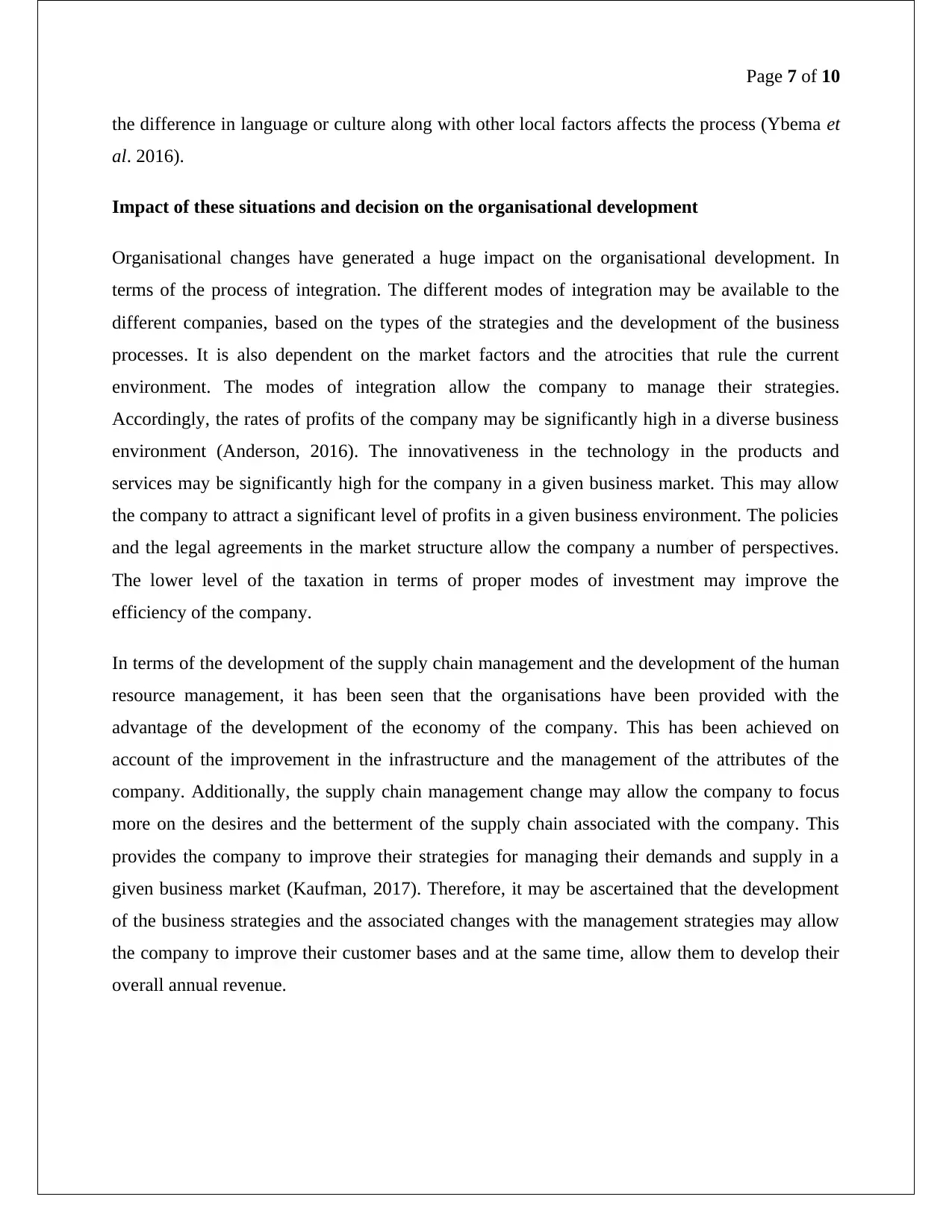
Page 7 of 10
the difference in language or culture along with other local factors affects the process (Ybema et
al. 2016).
Impact of these situations and decision on the organisational development
Organisational changes have generated a huge impact on the organisational development. In
terms of the process of integration. The different modes of integration may be available to the
different companies, based on the types of the strategies and the development of the business
processes. It is also dependent on the market factors and the atrocities that rule the current
environment. The modes of integration allow the company to manage their strategies.
Accordingly, the rates of profits of the company may be significantly high in a diverse business
environment (Anderson, 2016). The innovativeness in the technology in the products and
services may be significantly high for the company in a given business market. This may allow
the company to attract a significant level of profits in a given business environment. The policies
and the legal agreements in the market structure allow the company a number of perspectives.
The lower level of the taxation in terms of proper modes of investment may improve the
efficiency of the company.
In terms of the development of the supply chain management and the development of the human
resource management, it has been seen that the organisations have been provided with the
advantage of the development of the economy of the company. This has been achieved on
account of the improvement in the infrastructure and the management of the attributes of the
company. Additionally, the supply chain management change may allow the company to focus
more on the desires and the betterment of the supply chain associated with the company. This
provides the company to improve their strategies for managing their demands and supply in a
given business market (Kaufman, 2017). Therefore, it may be ascertained that the development
of the business strategies and the associated changes with the management strategies may allow
the company to improve their customer bases and at the same time, allow them to develop their
overall annual revenue.
the difference in language or culture along with other local factors affects the process (Ybema et
al. 2016).
Impact of these situations and decision on the organisational development
Organisational changes have generated a huge impact on the organisational development. In
terms of the process of integration. The different modes of integration may be available to the
different companies, based on the types of the strategies and the development of the business
processes. It is also dependent on the market factors and the atrocities that rule the current
environment. The modes of integration allow the company to manage their strategies.
Accordingly, the rates of profits of the company may be significantly high in a diverse business
environment (Anderson, 2016). The innovativeness in the technology in the products and
services may be significantly high for the company in a given business market. This may allow
the company to attract a significant level of profits in a given business environment. The policies
and the legal agreements in the market structure allow the company a number of perspectives.
The lower level of the taxation in terms of proper modes of investment may improve the
efficiency of the company.
In terms of the development of the supply chain management and the development of the human
resource management, it has been seen that the organisations have been provided with the
advantage of the development of the economy of the company. This has been achieved on
account of the improvement in the infrastructure and the management of the attributes of the
company. Additionally, the supply chain management change may allow the company to focus
more on the desires and the betterment of the supply chain associated with the company. This
provides the company to improve their strategies for managing their demands and supply in a
given business market (Kaufman, 2017). Therefore, it may be ascertained that the development
of the business strategies and the associated changes with the management strategies may allow
the company to improve their customer bases and at the same time, allow them to develop their
overall annual revenue.
Paraphrase This Document
Need a fresh take? Get an instant paraphrase of this document with our AI Paraphraser

Page 8 of 10
Conclusion
From this essay, it may be concluded that the organisational change is a beneficial process for
the development of an organisation in many ways. Although it has few impacts upon the
organisational strategies. It can be more beneficial if a reliable defence system of the
organisational will not break its policies. Adoptions of latest technologies within the
organisations may also help in generating a beneficial impact upon the organisations. Moreover,
in order to generate a new link with the market, organisations will not fully depend upon the
external agents. Instead of these, some preferences should be provided for the internal agents
also in respect to strengthen the inner networks of the provided company.
Conclusion
From this essay, it may be concluded that the organisational change is a beneficial process for
the development of an organisation in many ways. Although it has few impacts upon the
organisational strategies. It can be more beneficial if a reliable defence system of the
organisational will not break its policies. Adoptions of latest technologies within the
organisations may also help in generating a beneficial impact upon the organisations. Moreover,
in order to generate a new link with the market, organisations will not fully depend upon the
external agents. Instead of these, some preferences should be provided for the internal agents
also in respect to strengthen the inner networks of the provided company.
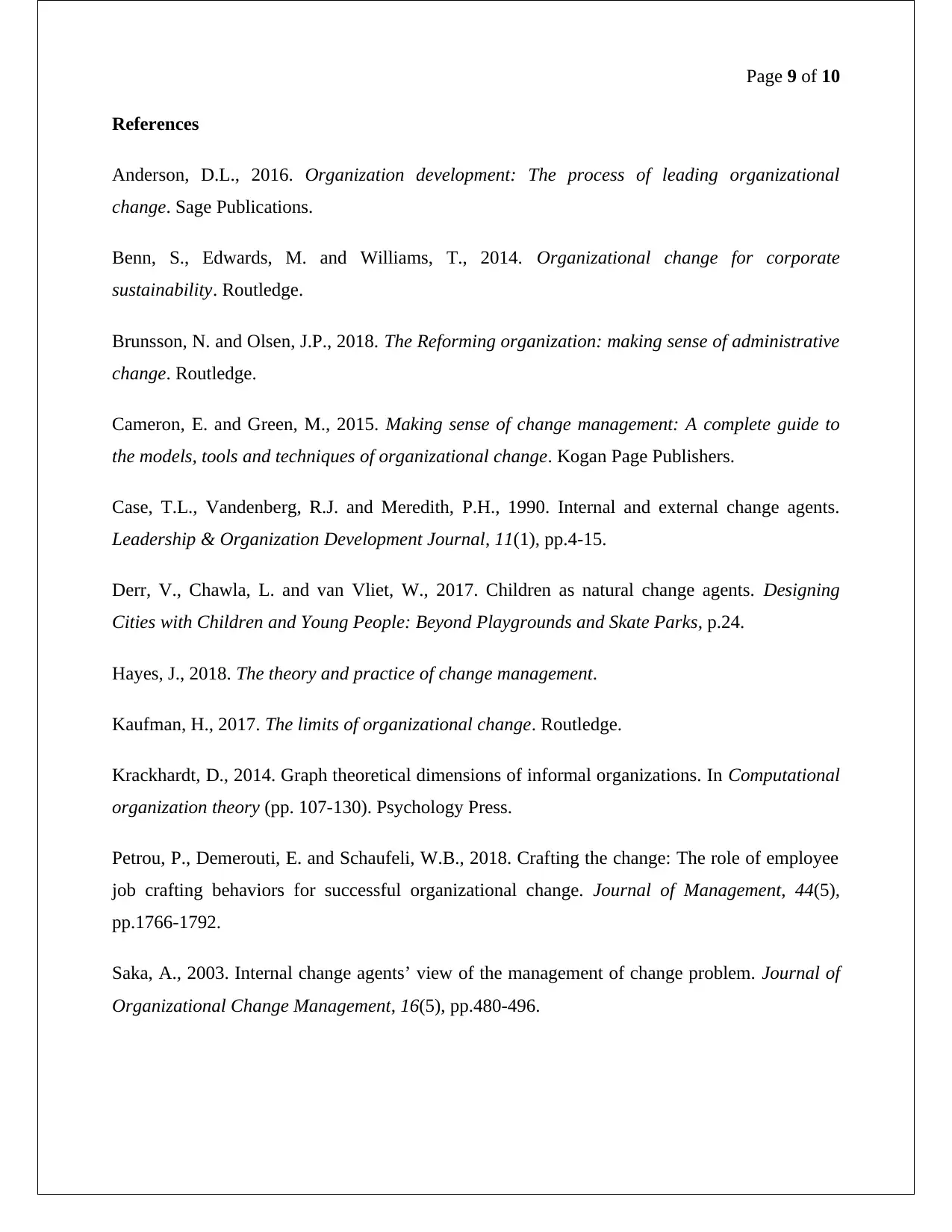
Page 9 of 10
References
Anderson, D.L., 2016. Organization development: The process of leading organizational
change. Sage Publications.
Benn, S., Edwards, M. and Williams, T., 2014. Organizational change for corporate
sustainability. Routledge.
Brunsson, N. and Olsen, J.P., 2018. The Reforming organization: making sense of administrative
change. Routledge.
Cameron, E. and Green, M., 2015. Making sense of change management: A complete guide to
the models, tools and techniques of organizational change. Kogan Page Publishers.
Case, T.L., Vandenberg, R.J. and Meredith, P.H., 1990. Internal and external change agents.
Leadership & Organization Development Journal, 11(1), pp.4-15.
Derr, V., Chawla, L. and van Vliet, W., 2017. Children as natural change agents. Designing
Cities with Children and Young People: Beyond Playgrounds and Skate Parks, p.24.
Hayes, J., 2018. The theory and practice of change management.
Kaufman, H., 2017. The limits of organizational change. Routledge.
Krackhardt, D., 2014. Graph theoretical dimensions of informal organizations. In Computational
organization theory (pp. 107-130). Psychology Press.
Petrou, P., Demerouti, E. and Schaufeli, W.B., 2018. Crafting the change: The role of employee
job crafting behaviors for successful organizational change. Journal of Management, 44(5),
pp.1766-1792.
Saka, A., 2003. Internal change agents’ view of the management of change problem. Journal of
Organizational Change Management, 16(5), pp.480-496.
References
Anderson, D.L., 2016. Organization development: The process of leading organizational
change. Sage Publications.
Benn, S., Edwards, M. and Williams, T., 2014. Organizational change for corporate
sustainability. Routledge.
Brunsson, N. and Olsen, J.P., 2018. The Reforming organization: making sense of administrative
change. Routledge.
Cameron, E. and Green, M., 2015. Making sense of change management: A complete guide to
the models, tools and techniques of organizational change. Kogan Page Publishers.
Case, T.L., Vandenberg, R.J. and Meredith, P.H., 1990. Internal and external change agents.
Leadership & Organization Development Journal, 11(1), pp.4-15.
Derr, V., Chawla, L. and van Vliet, W., 2017. Children as natural change agents. Designing
Cities with Children and Young People: Beyond Playgrounds and Skate Parks, p.24.
Hayes, J., 2018. The theory and practice of change management.
Kaufman, H., 2017. The limits of organizational change. Routledge.
Krackhardt, D., 2014. Graph theoretical dimensions of informal organizations. In Computational
organization theory (pp. 107-130). Psychology Press.
Petrou, P., Demerouti, E. and Schaufeli, W.B., 2018. Crafting the change: The role of employee
job crafting behaviors for successful organizational change. Journal of Management, 44(5),
pp.1766-1792.
Saka, A., 2003. Internal change agents’ view of the management of change problem. Journal of
Organizational Change Management, 16(5), pp.480-496.
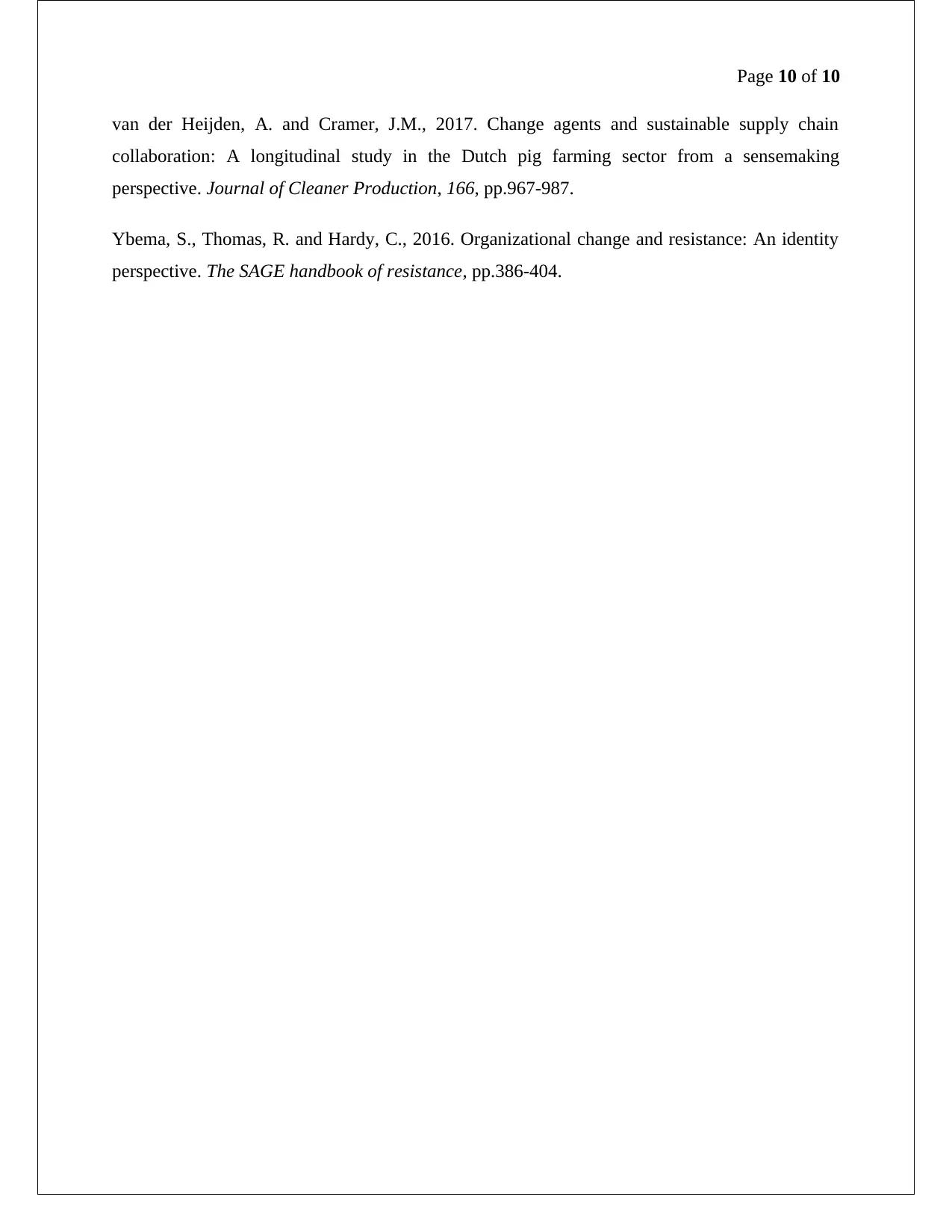
Page 10 of 10
van der Heijden, A. and Cramer, J.M., 2017. Change agents and sustainable supply chain
collaboration: A longitudinal study in the Dutch pig farming sector from a sensemaking
perspective. Journal of Cleaner Production, 166, pp.967-987.
Ybema, S., Thomas, R. and Hardy, C., 2016. Organizational change and resistance: An identity
perspective. The SAGE handbook of resistance, pp.386-404.
van der Heijden, A. and Cramer, J.M., 2017. Change agents and sustainable supply chain
collaboration: A longitudinal study in the Dutch pig farming sector from a sensemaking
perspective. Journal of Cleaner Production, 166, pp.967-987.
Ybema, S., Thomas, R. and Hardy, C., 2016. Organizational change and resistance: An identity
perspective. The SAGE handbook of resistance, pp.386-404.
1 out of 10
Related Documents
Your All-in-One AI-Powered Toolkit for Academic Success.
+13062052269
info@desklib.com
Available 24*7 on WhatsApp / Email
![[object Object]](/_next/static/media/star-bottom.7253800d.svg)
Unlock your academic potential
© 2024 | Zucol Services PVT LTD | All rights reserved.





